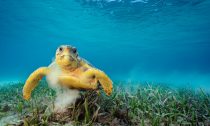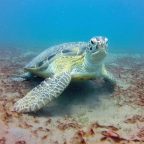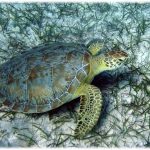
Loggerhead Sea Turtles migrate thousands of miles through the world’s oceans, but they don’t travel solo – research shows they carry surprisingly diverse and abundant populations of tiny creatures on their shells.
A new paper published May 20 in the journal Diversity shows that loggerhead sea turtles carry an average of 34,000 individual meiofauna – tiny organisms smaller than one millimeter – on their backs. One loggerhead carried nearly 150,000 individual animals on its shell, including nematodes, crustacean larvae, and shrimp.
“There literally is a [whole] world on there,” says Jeroen Ingels, a marine ecologist at Florida State University. It’s wild to find “that kind of diversity on another organism.”
Ingels and his team discovered more than a hundred new species of meiofauna, mostly nematodes, that hadn’t previously been found on loggerheads or other turtles. The team made their findings examining 24 loggerheads that arrived at St. George Island, Florida, in June 2018.
It was previously known that turtles carried some hitchhikers – but this quantity and degree of diversity hadn’t been seen before, Ingels says.
Studies of these tiny hitchhikers may help researchers trace the travels of these and other sea turtles, since certain meiofauna are unique to specific regions, which could guide future efforts to protect loggerheads. The research may also help explain how the tiny animals move about the ocean, which remains a mystery.
Floating worlds
“Meiofauna occupy all the tiny spaces that other organisms can’t,” Ingels says, so it’s expected to find them on turtles. But the sheer number came as a surprise, he says.
These microscopic animals include nematodes, which look like tiny worms and are found in just about every environment on Earth, from the deep sea to the soil of the highest mountains. They also found shrimp-like creatures called amphipods, tiny crustaceans called copepods, and jellyfish-like predators called hydroids.
Life on the shell is competitive, says Ingels. Many larger hitchhikers such as shrimp and crabs often prey on smaller shell inhabitants. Nematodes eat the bacteria and detritus that settles on the shell and, in some cases, they even eat other nematodes.
“It is a hugely diverse little microscopic world that is interacting, that we know very little about,” Ingels says.
Some of the larger animals such as barnacles can encrust and damage a turtle’s shell and increase drag, but they can also aid in camouflage. The tiny meiofauna, however, are unlikely to harm them. “Turtles have parasites and pests, no doubt, but meiofauna are not part of that.”
Nathan Robinson, a sea turtle researcher at Fundación Oceanogràfic, in Valencia, Spain, who was not involved in this research, says it makes sense that sea turtle shells are abundantly covered in life. “You have this perfect kind of platform, this raft, for cruising around the ocean,” he says. “It means you’re perpetually getting dragged in this wonderful current full of food,” a huge benefit for filter-feeders like barnacles and sponges.
Careful collection
Ingels and colleagues study loggerheads on St. George Island because it is one of the densest nesting sites in the northern Gulf of Mexico. To find the animals, they use red-tinted head lamps, a wavelength of light that is less disturbing to the turtles and which doesn’t interfere with human night vision. To work with the turtles, researchers must receive training and certification from the Florida Fish and Wildlife Conservation Commission.
Ingels and fellow researchers work quickly to sample the turtles, and only approach the turtle after she is on her way back to the sea. “It’s crucial that we do not interrupt the chances of a turtle laying all her eggs,” Ingels says.
During collection, the scientists crouch around the animal and use plastic putty knives to gently free the hitchhiking creatures they can see. Next they use sponges soaked in fresh water to collect tiny organisms too small for the naked eye.
Next, in the lab, they use fine mesh sieves to filter out larger organisms like mollusks and small crabs from the tiny meiofauna. Under a microscope, they begin sorting and identifying what they have found.
“The first time you see that sample, it’s always so exciting because you don’t know what you’re going to see,” says Ingels.
Ingels can’t study the loggerheads that are returning to nest this June, due to restrictions associated with the coronavirus pandemic, but he’s eager to see what new critters the turtles will come back with next year – especially the ones that have already been studied and marked.
Microorganism ferries
The study raises questions about how these tiny animals get on the turtles in the first place—and how important turtles are for moving them about.
It’s likely the turtles pick up many of the hitchhikers when they feed along the seafloor, a hotspot for meiofaua, stirring up microscopic critters that may find new real estate on a turtle’s shell, Ingels says.
Theodora Pinou, a sea turtle biologist and professor at Western Connecticut State University who was not involved in the research, says the turtles likely acquire so many hitchhikers merely as a result of their activities or environment, not because there’s anything particularly special or hospitable about their shells.
“I don’t think the turtle is the magnet,” Pinou says. Pinou has found that loggerheads living in the Atlantic Ocean carry more tiny ocean-hitchhikers than their Pacific counterparts. She suspects that’s a result of differences in environmental conditions and differing levels of meiofauna abundance.
Regardless of how the tiny animals happen upon the turtles, the reptiles do act as rafts, distributing hitchhikers over distances as they migrate. This may help explain how many tiny animals have become well-distributed, which remains something of a mystery, as many of these creatures cannot swim far or survive in the open ocean for long distances.
“A piece of floating goose barnacles or sea ice may transfer certain organisms, but it’s a different scale and frequency than when you’re talking about sea turtles,” Ingels says.
Biological trackers
Sea turtles’ long travels make them difficult and expensive to track. Ingels hopes that analyzing these tiny turtle hitchhikers and what they eat could provide clues on where the turtles picked them up, or where they’ve traveled, and Ingels hopes to perform such tests in the future.
Studies of this kind haven’t been performed on meiofauna yet. But researchers have examined the chemical makeup of barnacles atop green and loggerhead sea turtles. This work shows that the isotopes, or chemical variants, within the barnacles provide a record of conditions in the places they’ve traveled, like temperature and salinity, which can be used to infer migration routes.
“The closer you look at these animals, the more there is to discover,” Robinson says.















Social Profiles